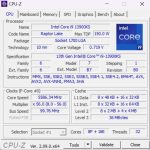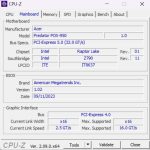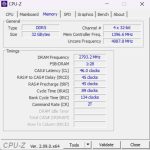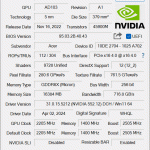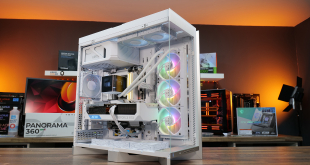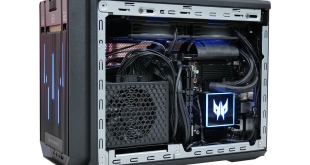
The Acer Predator Orion X should already be familiar to our readers, as we presented a showcase of this small form-factor PC at the end of last year. Today we are back with a full review of the system however, and we are assessing the model that is on sale here in the UK. That means it is packing an i9-13900KS CPU, RTX 4080 GPU, 32GB of DDR5 memory and two 1TB SSDs.
If you caught our showcase at the end of the year, you will know the sample we were sent was an early prototype with RTX 4090 graphics, so it wasn't fully representative of the system that UK buyers can get their hands on via Currys for £3299 (reduced from £3799). The system we are reviewing today, however, is a final retail model of the Acer Predator Orion X, the exact same if you went and bought one yourself, so we can give it a full technical analysis.
Specification:
At its core, the Acer Predator Orion X is a small-form factor mini PC with a total chassis volume of 15.4L, so while it's not quite as compact as a console, it's a relatively small unit as gaming PCs go. It's using a custom-made dual-chamber case that you can access by lifting the levers on the front panel, and then both side panels pop out and can be lifted away.
The right-hand side (or Zone 1, as Acer calls it) is home to the motherboard, CPU, memory, storage and power supply, while a PCIe riser cable is used to connect to the graphics card on the other side of the case in Zone 2. There is also a third Zone but this only gives access to the top panel and the AIO liquid cooler's screws, so it's not that useful.
Starting in Zone 1 then, Acer has fitted an ITX Z790 motherboard, though that's the only details shared on the spec sheet. It seems to be a custom job designed for the Orion X and has its own custom Acer BIOS, but who the actual manufacturer is, I'm not sure, and it certainly looks fairly basic on first impressions. An i9-13900KS CPU is plugged into the board, which is technically now a last-gen part, but still offers eight Raptor Lake P-cores and sixteen E-cores, though we take a closer look at performance later in the video. That CPU is cooled by a compact 240mm AIO, with the fans set to exhaust out of the roof, so it'll be interesting to see how it deals with the heat of the 13900KS.
Memory also appears to be custom for this system, with 32GB of DDR5, clocked at 5600MT/s, bearing the Predator logo. There's also two internal M.2 slots, but both are occupied by 1TB Micron MTFDKBA1T0TFK-1BC15ABYY PCIe Gen3 SSDs. Just 2TB in a system that costs over three grand feels a little cheap to me, as does the fact these are only Gen3 SSDs when Gen5 drives are now well established. If you want to add more storage however, there is a removable hot-swap enclosure found in the front panel, which users can open and install another M.2 SSD, though it is empty by default – but I think that's a nifty inclusion.
Over in Zone 2, the only component is the graphics card, an RTX 4080 (non-Super) that again looks custom-made for the Predator Orion X. It's a triple-fan and triple-slot unit, though it runs at a stock speed of 2505MHz, so hasn't been factory overclocked. That's all powered by the compact 850W PSU, and again we have no details on it other than the fact that it is an 80 Plus Gold SFX unit, which should be fine for this spec.
Overall port selection is quite basic, too. There's a total of five full-size USB ports on the rear, and one Type-C that's USB 3.2 Gen 2X2, alongside Ethernet and audio jacks, but that's it round the back. On the front panel there's another Type-C USB 3.2 Gen 2X2 and one 3.2 Gen 1 Type-A, alongside audio and mic jacks.
RGB lighting can also be found on the front panel, on the CPU block and with the liquid cooler's fans, and this can all be synchronised using the PredatorSense app that comes pre-installed.
 KitGuru KitGuru.net – Tech News | Hardware News | Hardware Reviews | IOS | Mobile | Gaming | Graphics Cards
KitGuru KitGuru.net – Tech News | Hardware News | Hardware Reviews | IOS | Mobile | Gaming | Graphics Cards











